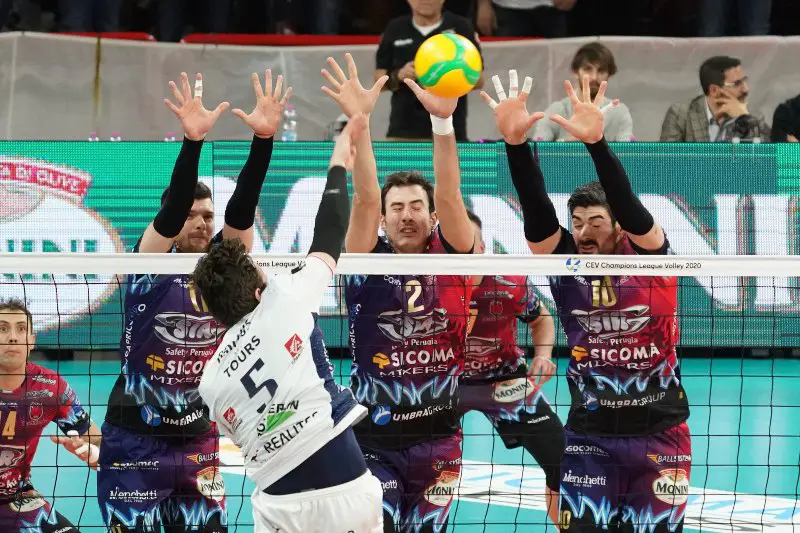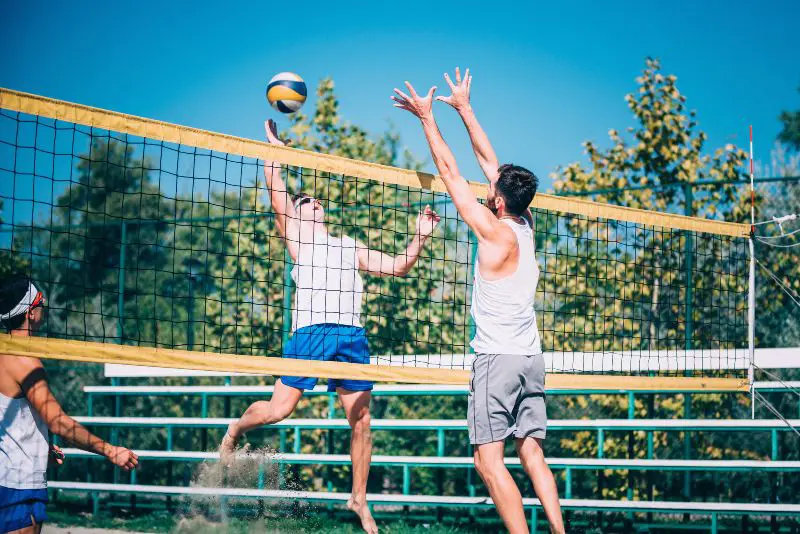
Volleyball is a sport where agility plays a huge role for any team’s success! Indeed, most average teams are lacking the aspect in their game which usually cost them many points and eventually the victory …
In this article, I breakdown the importance of agility in volleyball and the tremendous difference it can make on an individual level and on a team level …
I also address some effective tips to improve your agility in volleyball!
Reasons why volleyball require agility?
Nature of movements
Agility is needed because of the quick and sometimes awkward movements the sport requires where players have to adjust their bodies to the ball while playing…
As a volleyball player, you must have the ability to change direction, sometimes even in midair, in a split second to adjust to the ball.
Volleyball agility or movement exercises are, therefore, very important and should be modeled after what the player is likely to experience during the course of the game.
Helpful Tip: To help your overall agility, I highly recommend using volleyball shoes with quite high midsoles. The latter is responsible for absorbing most of the shocks resulting of volleyball moves. This will encourage you to execute those movements much easier & faster. For example, these volleyball shoes come with quality & high midsoles.
Explosiveness
Volleyball requires explosive jumps as well, apart from the rapid changes in direction. The ability to jump high is a treasured characteristic amongst volleyball players because of the importance of spiking and blocking balls …
Vertical jumping involves a lot of ground force production, core stability, and quick hip movements.
In order for players to improve their vertical jumps, they need to practice exercises that strengthen their hip and leg muscles.
Volleyball positions that require agility the most …
Setter
The setter is the main contributor to the offense of any volleyball team, and as such, needs to be agile in their movements…
The biggest requirement of the setter is that they should have a delicate touch to set the ball perfectly for one of the attacking players.
If a setter is not agile, the coordination and balance required for this job would not be done properly.
Outside hitter
The outside hitter, or the left-side hitter, is the lead attacker of the team in the offensive strategy. The player needs to be able to jump high, be quick on their feet, and be ready to adapt to different situations.
If a player in this position is lacking agility, they would not be able to carry out the team’s offense strategy properly, making the team lose.
Opposite Hitter
Also known as the right-side hitter, players in this position need to have a perfect balance of both defense and offense.
They also get many opportunities to hit the ball, so just like the outside hitter, they also need to be agile and able to jump quickly and also change directions suddenly and as required.
You can also learn these other needed skills for these volleyball positions!
Volleyball drills & exercises to work on your agility …
Cone Hop with backpedal
For doing this agility drill, you need to have either 3 or 5 cones. If the exercise is being done by younger volleyball players, 3 cones will be enough.
You need 5 cones if the drill is being practiced by adult players. When volleyball players get used to this drill, the number of cones can be varied as they want.
Cone hop with backpedal is a drill that can be done by setters, blockers, and attackers.
Here are the main steps …
- Place all the cones on the court, making sure they form a straight line.
- The task of the player is to jump laterally over the cones.
- When jumping, it is important that the players look forward.
- Additionally, the player’s shoulders should stay over the hips during the drill.
Doing this volleyball drill will have a great impact on the player’s agility. This exercise also helps the players practice injury prevention.
Doing this agility exercise is all about how to jump from a controlled position and also land in a controlled position.
While doing this exercise, you have the opportunity to learn how to land after doing the jumps in the correct way.
Figure 8 backpedal with sprint
The figure 8 backpedal with spring is a great volleyball agility drill with cones. The exercise only needs 2 cones. One of the biggest benefits of this exercise is that it lets players move quickly in any direction of the court.
Here’s how to do this drill:
- To begin with, set up the cones on the court.
- The distance between the cones should be around ten feet.
- A player has to stand near the first cone.
- The drill begins as the player has to sprint through and around the second cone.
- Then, the player changes direction and moves all the way back to the first cone.
As a result of this drill, the player will form the figure 8 with their movements. While performing a player has to aim to keep their head high and their eyes forward.
If he performs this type of drill regularly, they should be able to change their direction on the court during the games and practices much more quickly over a period of time.
T-Drill
The T-drill exercise is a perfect way to improve agility for volleyball. This exercise needs 4 cones …
Again, begin by setting up the cones on the court. You have to make sure that the cones form the letter ‘T’ on the court.
The T drill exercise is focused on doing lateral movements. This means that a volleyball player has to move laterally between the cones during the drill. You can move in any direction, this is up to the players.
Finally, you can also learn these drills to become faster in volleyball …
Does training volleyball in the sand help developing agility for indoor?

Practicing beach volleyball and training in the sand is definitely one of the best methods to improve indoor volleyball players’ agility and strength …
Due to this, it is becoming common for indoor volleyball players to practice in the sand during their off-season!
Playing sand volleyball helps indoor volleyball players to increase their physical capabilities. Because of the nature of the game and the unstable surface of the sand, it is a great training tool that helps increase the players’ stability, agility and aids in their core strength training.
Since a beach volleyball player does it all, block, set, and hit as well, if there are any weak points in an indoor volleyball player, playing on the sand will help them work on all the areas where they need work.
Playing on the sand helps an indoor player become a well-rounded and developed volleyball player.
Other important fitness components for volleyball …
Strength and Power
Volleyball requires a lot of strength and power. Players need power, especially in their legs, to jump higher … They need stability and strength in their upper body to spike, block, and dig balls.
Lifting weights regularly is an excellent idea as it stimulates muscles fibers to grow. This allows players to produce more force at faster rates.
So as players get stronger, their explosive power also increases dramatically on the court.
Strengthening volleyball-specific muscles will ensure that players are able to achieve their maximum performance potential during the game.
It is important to understand that core strength is a key component for a volleyball player. This is vital for the player’s stability and allows hitters to transition their power more efficiently from their lower body to their upper body and arm swing.
Muscle fibers grow when the stress of strength training directly stimulates them. This makes weight lifting one of the best tools for volleyball players to develop the power to serve more forcefully and jump higher.
Jumping
Volleyball players need to make explosive jumps and rapid changes in their direction. The ability to jump high is, therefore, a valuable ability for spiking the ball and for defending spikes from the opposing team as well (You can learn these drills to improve your vertical jumps)
Vertical jumping focuses all on ground force production, quick hips, and core stability. So for players to improve their vertical jumps, they need to spend time in the weight room doing squats, deadlifts, and other exercises that strengthen their hip and leg muscles.
Furthermore, players have to be able to track and quickly change directions to keep the ball in play if they want to continue winning points. Having an effective strength and conditioning program that incorporates agility drills and lateral movements to improve foot speed is important.
Keep in mind that footwork is also an important volleyball skill that you should not sleep on …
Flexibility and injury prevention
The important part for any volleyball team is that their players not only need to be strong, skillful, and powerful, but they also need to be healthy.
Volleyball is a high-impact sport, and with all the landing, jumping, cutting, and planting involved, a player’s body can surely take a beating.
The tendons, muscles, and ligaments surrounding the joints help keep a player safe from injury, but strenuous volleyball movements can weaken these joints temporarily.
This is why it is important to take proper care of oneself. Without sufficient muscle strength or recovery time, players are at a greater risk of experiencing injuries.
Overuse injuries can include back pain, patellofemoral syndrome, shin splints, and shoulder impingements.
Increasing strength levels will reduce the risk of injury and also of muscle vulnerability. Stronger muscles will be better able to absorb the shocks from landings and quick direction changes.
Focusing on building a foundation of balanced strength and flexibility allows the muscles to work together to minimize the stress on the ligaments and joints.
Flexibility also increases the range of motion, improves overall technique, and allows the player to exert more force.
Final Thoughts …
Agility drills I’ve detailed above are of course important to help you in that department. Yet, you should not focus too much on them …
Indeed, the nature of volleyball games and training sessions help making you naturally more agile overall. So, even if you don’t specifically train for that, this doesn’t necessarily mean that you are lacking this quality.
However, if you’ve noticed that you are lacking this aspect in your game, then at that time it would be a great idea to address that with those specific drills.
